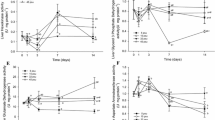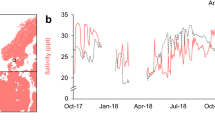Abstract
Crassostrea virginica (Gmelin) collected in 1989 from several sites within the Chesapeake Bay have narrower salinity tolerances than conspecific oysters collected in 1989 from several Atlantic coast sites (Georgia to Cape Cod). The basis of this physiological difference appears to be the biochemical mechanisms that control cellular osmolality following salinity stress. When adapted to the same salinity, the amino acid pools of both gill and adductor muscles of Atlantic oysters are larger than those of Bay oysters and different in composition. The Atlantic oyster tissues rely primarily on taurine for salinity tolerance, while the Bay oyster tissues have relatively less taurine, depending instead upon alanine, glycine and proline to adapt to high salinity. In addition, Atlantic oyster gill and adductor have 10 to 25 times the glycine betaine concentrations of these tissues from Bay oysters, depending upor the salinity of acclimation. The betaine concentration varies with salinity in Atlantic oysters, but does not change in Bay oysters. The results suggest that these biochemical differences are the basis of the narrower salinity tolerance in Bay oysters. The biochemical differences may reflect genetic differences between Bay and Atlantic oysters.
Similar content being viewed by others
Literature cited
Andrews, J. D. (1966). Oyster mortalities studies in Virigina. V. Epizootiology of MSX, a protistan pathogen of oysters. Ecology 47: 19–31
Baginski, R. M., Pierce, S. K. (1977). The time course of intracellular free amino acid accumulation in tissues of M. d. demissus. Comp. Biochem. Physiol. 57A: 407–422
Baginski, R. M., Pierce, S. K., (1978). A comparison of amino acid accumulation during high salinity adaptation with anaerobic metabolism in the ribbed mussel, Modiolus demissus. J. exp. Zool. 203: 419–428
Bagnasco, S., Balaban, R., Fales, H. M., Yang, Y., Berg, M. (1986). Predominant osmotically active organic solutes in rat and rabbit renal medullas. J. biol. Chem. 261: 5872–5877
Bishop, S. H., Ellis, L. L., Burcham, J. M. (1983). Amino acid metabolism in molluscs. In: Wilbur, K. M. (ed.) The Mollusca. Metabolic biochemistry and molecular biomechanics, Vol. 1. Academic Press, New York, p. 243–327
Bishop, S. H., Greenwalt, D. E., Burcham, J. M. (1981). Amino acid cycling in ribbed mussel tissues subjected to hyperosmotic shock. J. exp. Zool. 215: 277–287
Blunden, G., Cripps, A. L., Gordon, S. M., Mason, T. G., Turner, C. H. (1986). The characterisation and quantitative estimation of betaines in commercial sea weed extracts. Bot. Mar. 29: 155–160
Briteaux-Gregoire, S., Duchateau-Bosson, Ch., Jeuniaux, Ch., Florkin, M. (1964). Constituants osmotiquement actifs des muscles adducteurs d'Ostrea edulis adaptee a l'eau de mer ou a l'eau saumatre. Archs int. Physiol. Biochim. 72: 267–275
Chambers, S. T., Kunin, C. M. (1987). Isolation of glycine betaine and proline betaine from human urine. J. clin. Invest. 79: 731–737
DeRidder, J. M., VanDam, K. (1973). The efflux of betaine from rat liver mitochondria, a possible regulating step in choline oxidation. Biochim. biophys. Acta 291: 557–563
Dragolovich, J. (1991). The control of glycine betaine synthesis and its role in the cellular adaptation to hyperosmotic stress. Ph. D. Dissertation, University of Maryland, College Park, Maryland
Flowers, T. J., Troke, P. F., Yeo, A. R. (1977). The mechanism of salt tolerance in halophytes. Annu. Rev. Plant Physiol. 28: 89–121
Ford, S. E., Haskin, H. H. (1982). History and epizootiology of Haplosporidium nelsoni (MSX), an oyster pathogen in Delaware Bay, 1957–1980. J. Invertebr. Path. 40: 118–141
Hand, S. C., Stickle, W. B. (1977). Effects of tidal fluctuations of salinity on pericardial fluid composition in the American oyster, Crassostrea virginica. Mar. Biol. 42: 259–271
Harlocker, S. L., Kapper, M. A., Greenwalt, D. E., Bishop, S. H. (1991). Phosphoenol carboxykinase from ribbed mussel gill tissue: reactivity with metal ions, kinetics and action of 3-mercaptopicolinic acid. J. exp. Zool. 257: 285–298
Jolivet, Y., Hamelin, J., Larher, F. (1983). Osmoregulation in halophytic higher plants: the protective effect of glycine betaine and other related solutes against the oxalate destabilization of membranes in beet root cells. Z. Pfl. Physiol. 109: 171–180
Krantz, G. E. (1991). Maryland oyster population status report. Maryland Department of Natural Resources, Annapolis, Maryland
Landfald, B., Strom, A. (1986). Choline-glycine betaine pathway confers a high level of osmotic tolerance in Escherichia coli. J. Bact. 165: 849–855
Le Rudulier, D., Bernard, T. (1986). Salt tolerance in Rhizobium: a possible role for betaines. Fedn eur. microbiol. Soc. (FEMS) Microbiol. Rev. 39: 67–72
Le Rudulier, D., Bernard, T., Goas, G. (1984a). Osmoregulation in Klebsiella pneumoniae: enhancement of anaerobic growth and nitrogen fixation under stress by proline betaine, butryro-betaine and other related compounds. Can. J. Microbiol. 30: 299–305
Le Rudulier, D., Strom, A. R., Dandekar, A. M., Smith, L. T., Valintine, R. C. (1984b). Molecular biology of osmoregulation. Science, N.Y. 224: 1064–1068
Lynch, M. P., Wood, L. (1966). Effects of environmental salinity on free amino acids of Crassostrea virginica Gmelin. Comp. Biochem. Physiol. 19: 783–790
McCormick, A., Paynter, K. T., Brodey, M. M., Bishop, S. H. (1986). Aspartate aminotransferases from ribbed mussel gill tissue: reactivity with β-L-Cysteinesulfinic acid and other properties. Comp. Biochem. Physiol. 84B: 163–166
Newell, R. I. E. (1985). Physiological effects of the MSX parasite Haplosporidium nelsoni (Haskin, Stauber & Mackin) on the American oyster Crassostrea viriginica (Gmelin). J. Shellfish Res. 5: 91–95
Pan, S., Moreau, R. A., Yu, C., Huang, A. H. C. (1981). Betaine accumulation and betaine aldehyde dehydrogenase in spinach leaves. Plant Physiol., Wash. 67: 1105–1108
Paynter, K. T., Hoffmann, R. J., Ellis, L. L., Bishop, S. H. (1984). Partial characterization of the cytosolic and mitochondrial aspartate amino-transferase from ribbed mussel gill tissue. J. exp. Zool. 231: 185–197
Paynter, K. T., Karam, G. A., Ellis, L. L., Bishop, S. H. (1985). Pyruvate dehydrogenase complex from ribbed mussel gill mitochondria. J. exp. Zool. 236: 251–533
Pierce, S. K. (1970). The water balance of Modiolus (Mollusca: Bivalvia: Mytilidae): osmotic concentrations in changing salinities. Comp. Biochem. Physiol. 36: 521–533
Pierce, S. K. (1982). Invertebrate cell volume control mechanisms: a coordinated use of intracellular amino acids and inorganic ions as osmotic solute. Biol. Bull. mar. biol. Lab., Woods Hole 163: 405–419
Pierce, S. K., Politis, A. D. (1990). Ca2+-activated cell volume recovery mechanisms. Annu. Rev. Physiol. 52: 27–42
Storey, R., Wyn Jones, R. G. (1977). Quaternary ammonium compounds in plants in relation to salt resistance. Phytochem. 16: 447–453
Styrvold, O. B., Falkenberg, P., Landfald, B., Eshou, M. W., Bjornsen, T., Strom, A. R. (1986). Selection, mapping and characterization of osmoregulatory mutants of E. coli blocked in the choline-glycine betaine pathway. J. Bact. 165: 856–863
Warren, M. K., Pierce, S. K., (1982). Two cell volume regulatory systems in the Limulus myocardium: an interaction of ions and and quaternary ammonium compounds. Biol. Bull. mar. biol. Lab., Woods Hole 163: 504–516
Yancey, P. H., Clark, M. E., Hand, S. C., Bowlus, R. D., Somero, G. N. (1982). Living with water stress: evolution of osmolyte systems. Science, N.Y. 217: 1212–1222
Author information
Authors and Affiliations
Additional information
Communicated by J. Grassle, New Brunswick
Rights and permissions
About this article
Cite this article
Pierce, S.K., Rowland-Faux, L.M. & O'Brien, S.M. Different salinity tolerance mechanisms in Atlantic and Chesapeake Bay conspecific oysters: glycine betaine and amino acid pool variations. Marine Biology 113, 107–115 (1992). https://doi.org/10.1007/BF00367644
Accepted:
Issue Date:
DOI: https://doi.org/10.1007/BF00367644




